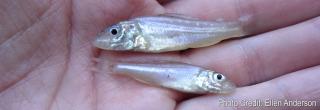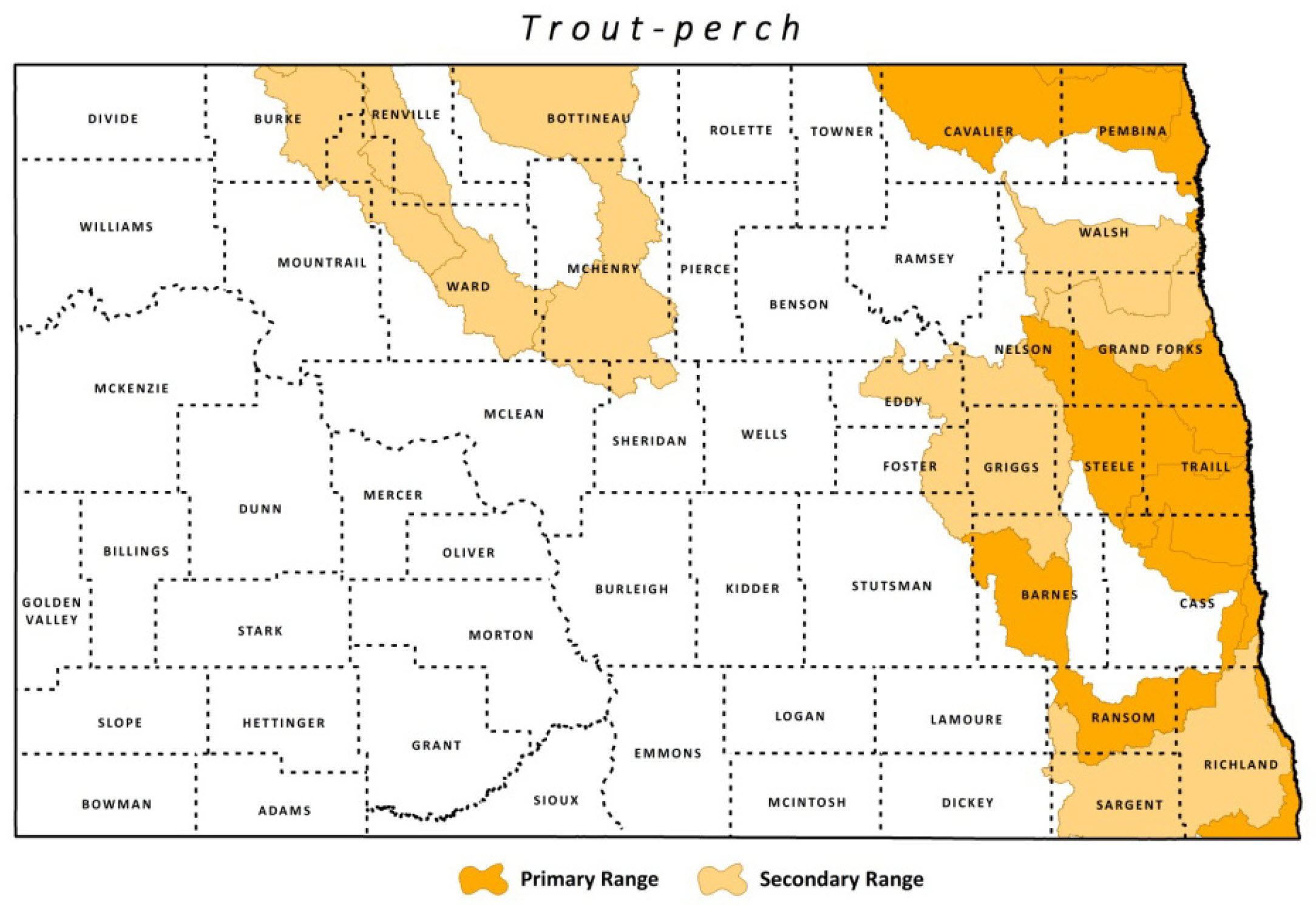
Trout-Perch
| Scientific Name | Percopsis omiscomaycus |
|---|---|
| General Description | Grows to 7 inches. Light yellow in color with rows of dusky brown spots along the back. Top of head is unscaled. Pearly white spots on the underside of the head. Also has a small fleshy adipose fin near the tail. |
| Status | Year-round resident. |
| Abundance | Uncommon. |
| Primary Habitat | Primarily found in lakes, but may be found in deeper pools of rivers and streams. Bottoms substrate is normally sand. |
| Federal Status | None. |
| Reason for Designation | Imperiled in much of its northern range. Loss of suitable habitat seems to be the largest factor affecting this species. |
Locations and Conditions of Key Habitat
Preferred Habitat
Typically in lakes but also in deep flowing pools of creeks and small to large rivers; usually over sand. Spawns in shallow water over sand or gravel bars. Often spawns in streams in spring and uses deeper water during the rest of the year.
Key Areas for Trout-Perch in North Dakota
Found in the Red River system including the Sheyenne River. Recent surveys appear to indicate some expansion from historic distribution. Records also exist from the Souris River.
Problems Which May Affect this Species
Habitat
Land uses, most notably agricultural practices have changed the landscape and reduced the habitat quality for this species. Specifically, the use of ditches to drain wetlands has drastically changed the flow regime, and increased the levels of sediment and run-off that enter streams and rivers.
Other Natural or Manmade Factors
The addition of dams to the Red River drainage has changed the flow regime and fragmented populations. A decrease in water quality due to current land use practices in the Red River basin may have contributed to the decline of this species.
Research and Survey Efforts
Current Research or Surveys
- Currently no studies or surveys specifically targeting the Troutperch are in progress.
Previous Research or Surveys
- Red River basin streams were surveyed during the 1960s by the University of North Dakota (UND).
- In the late 1970s, Red River basin stream surveys were conducted by the Minnesota Department of Natural Resources, Ecological Services Section (MDNR ECO).
- A survey was conducted on the Red River during 1983 and 1984.
- Investigations of stream fishes in the Red River basin occurred during 1993 and 1994 as a part of two major studies.
- Several sites throughout the basin have been sampled for fishes using electro-fishing gear by the MDNR, Minnesota Pollution Control Agency (MPCA), North Dakota Department of Health (NDDH), U.S. Environmental Protection Agency (EPA), and the U.S. Geological Survey (USGS). These studies are a part of the USGS National Water Quality Assessment program (Stoner et al. 1993) and the development of an index of biotic integrity for fishes in the basin (Goldstein et al. 1994).
- A survey of the Sheyenne River and its tributaries within the Sheyenne National Grasslands was conducted by Brooks in 2000.
- South Dakota State University surveyed the stream fish of the Red River and its drainages in 2008.
- South Dakota State University surveyed western North Dakota streams in 2010.
- A survey effort was conducted in the Sheyenne River by Valley City State University in 2012.
- A survey effort was conducted in Baldhill Creek by Valley City State University in 2013.
Additional Research or Surveys Needed
- Re-examine sites where this species has been recorded.
- Develop a protocol to monitor stream fish.
Management Recommendations
- Protect rivers, streams, and riparian areas where possible (i.e. easements and/or acquisition).
- Work with partners to ensure Swampbuster provisions are maintained.
- Continue to use the Section 404 program to ensure affected rivers and riparian areas are mitigated to replace form and function.
- Continue to work with other federal agencies (i.e. FAA and FHWA) not covered by Section 404 or Swampbuster to ensure affected rivers and riparian areas are mitigated to replace form and function.
- Continue to work with NDSWC to develop minimum in-stream flow recommendations.
- Develop and promote incentive programs to restore riparian areas.
- Continue to work with ND 319 Task Force in prioritizing projects within impaired watersheds and implementing BMP’s.
- Develop and promote incentive programs for adjacent landowners to improve bank stability through land use changes (e.g. RRBRP).
- Promote non-traditional bank stabilization measures (i.e. root wads, willow waddles, vegetative slope).
- Implement intake conditions or recommendations (i.e. screening and velocity requirements).
- Work with the dam owners for potential removal or modification.
- Cooperate with Fisheries Division on state aquatic nuisance species plan.
- Survey areas of data gaps. Conduct research/surveys to establish baseline information on SCP.
- Continue to work with partners in promoting and distributing educational materials related to river, stream and riparian values and good stewardship.
Monitoring Plans
No monitoring plan has been identified for this species. The North Dakota Department of Health conducts Index of Biotic Integrity (IBI) for all North Dakota’s watersheds. This will document all species encountered.
2005-2015 Progress
The Trout-perch maintains a Level II Species of Conservation Priority ranking. SWG T-14-R Status of selected fishes with immediate conservation need in North Dakota provided important information on this species. Some evidence of range expansion was found.

Note: A listing of works consulted when compiling the information on this page may be found in the 2015 State Wildlife Action Plan.
